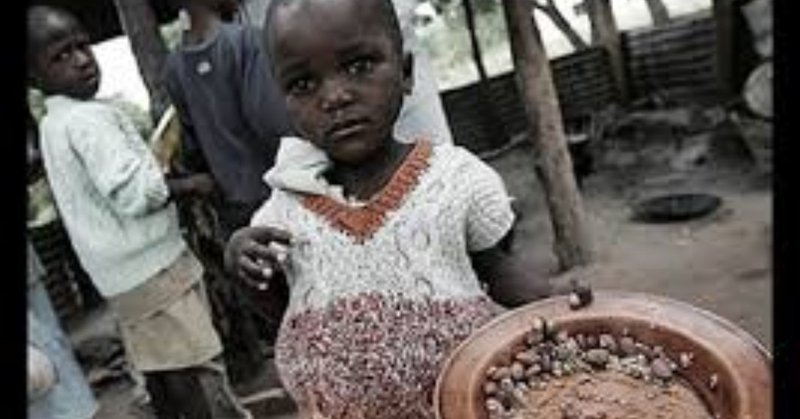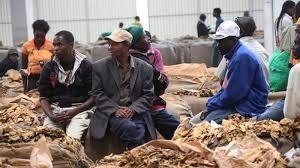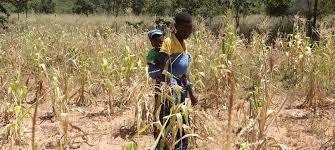
ZIMBABWE: Zim facing humanitarian crisis 人道支援危機に直面しているジンバブエ
ZIMBABWE INDEPENDENT
Posted on January 10, 2020 by The Independent in Main News
ZIMBABWE is facing one of its worst humanitarian crises in a decade with close to eight million people — half the country’s population — facing hunger.
According to a recent report by the United Nations (UN) special rapporteur on the right to food, Zimbabwe is hurtling towards “man-made starvation”. UN agencies like the World Food Programme (WFP) have scaled up drought assistance programmes to cater for the lean season (January to April). The UN agency is now appealing for US$200 million to provide food around the country as hunger stalks the most vulnerable communities. Zimbabwe Independent reporter Nyasha Chingono (NC) met WFP deputy country director Niels Balzar (NB) to discuss the agency’s humanitarian interventions. Below are excerpts of the interview: anb
NC: How dire is the drought situation in Zimbabwe and is it likely to worsen?
NB: Let me start by saying that as the World Food Programme, we are very worried about the situation on the ground. As you probably know, the latest

ジンバブエは10年間で最悪の「人道支援危機」に直面しており、800万人近くの人々(国人口半分)が餓死に直面しています。
食糧権利に関する国連(UN)の特別報告者によると、ジンバブエは「人工飢餓」に向かって急いでいます。世界食物合同計画(WFP)のような国際機関は、乾季(1月ー4月)に対応するため、干ばつ支援プログラムを拡大しました。国際機関は現在、飢餓が最も脆弱な地域社会に根付いているため、全国に2億米ドルを提供するよう訴えています。ジンバブエ独立記者のニャシャチンゴノ(N/C)は、WFP副国長のニールスバルザー(N/B)に会って、同機関の人道的介入について議論しました。以下はインタビューの抜粋です。
NCチンゴノ:ジンバブエの干ばつ状況はどれほどひどく、悪化する可能性がありますか?
注:世界食物合同計画として、「私たちは地球状況について」 「非常に心配している」と言って始めましょう。おそらく最新のエビデンスをご存知のように・・・
assessments that were done in 2019 show that almost half of the population, eight million people, are in need of some form of assistance during the peak of the lean season. The peak of the lean season, as you may be aware, is essentially the time between January, all the way up to April when the next harvest is coming. So this is the period when most people have run out of food and hunger is at its peak. And so obviously, in this year’s lean season, what we are responding to now is the outcome or the impact of a not very good harvest from 2018 and 2019.
Some did not harvest at all during the last harvest, some half-harvested, but at a suppressed scale. That is why we had already started our assistance in August last year to help those communities who had not harvested or had a very limited harvest. And as you may imagine, as we move through the season, more and more people are facing food insecurity. So we are gradually scaling up out of the eight million people that are food insecure. While originally the plan was to reach about two million right, with these new numbers we have now decided in coordination with the government to reach up to 4,1 million people during the peak of the lean season.
NC: How much funding do you require to provide food in Zimbabwe’s worst affected areas?
NB: We urgently need about US$200 million to provide this assistance for the peak of the lean season. But we already know now that given, as you just mentioned in the introduction, that we are most likely looking at another at least partially failed agricultural season. As such, we are likely to extend our support all the way into April and May, and most likely also start our assistance earlier than usual. That means as early again as August. I guess it is no secret Zimbabwe is obviously undergoing some economic reforms and those economic reforms are necessary. The economic reforms are necessary because I think sustainable food security is dependent on a functional economy that is growing. Having said this, I think the austerity economic reforms have had an immediate detrimental impact on the food security of many Zimbabweans. So it is a combination of climate change, as well as the economic crisis that we have at hand. And I would say given that context, it is fundamental for us to immediately, as soon as possible, receive this additional funding so that we can support people at commensurate scale.
NC: Which parts of the country are worst affected by drought and what is the WFP doing to help these communities?
2019年に行われた評価では、人口のほぼ半分である800万人が、乾季ピーク時に何らかの形で支援を必要としていることが示唆されています。ご存知かのように、乾季ピークは、基本的に1月から、次の収穫が来る4月までの季節。だから、ほとんどの人が食料を使い果たし、飢餓がピークに達する時期。そして、明らかに、今年の乾季シーズンにおいて、私たちが今対応しているのは、2018年と2019年の収穫が「良くない」という結果影響です。
いくつかは最後の収穫間に全く収穫できなかった、または、半分収穫されましたが、抑制された規模でした。そのため、昨年8月に収穫を行っていないか?、収穫が非常に限られていたコミュニティ支援のため、すでに支援を開始しました。そして、ご想像のとおり、季節が進むにつれて、ますます多くの人々が食料不安に直面しています。そのため、私たちは食料が不安定な800万人から徐々に規模拡大しています。当初、計画は、約200万人の権利に達することでしたが、これらの新しい人口により、現在、政府と協力して、乾季ピーク時に最大410万人に援助することにリーチすることを決定しました。
N/Cチンゴノ:ジンバブエの最悪の影響を受けた地域で食料を提供するには、どれくらいの資金が必要ですか?
N/Bバルザー:この支援を乾季ピークに提供するには、$約2億ドルが緊急に必要です。しかし、最初に述べたように、部分的に失敗した農業シーズンを検討している可能性が高いことは、わかっています。そのため、サポートを4月と5月まで延長し、通常よりも早くサポートを開始する可能性があります。それは8月においても必要ということです。ジンバブエが明らかに、経済改革を行っているのは明らかであり、経済改革が必要です。持続可能食料安全保障は成長している機能的経済に依存していると思うので、経済改革が必要です。ただし、私は緊縮財政改革が多くのジンバブエ人の食糧安全保障に即座に有害影響を及ぼしたと思います。ですから、それは気候変動と経済危機の組み合わせです。この文脈を考えると、私たちが相応規模で人々を支援できるように、この追加資金をすぐに、早く受け取ることが基本なのです。
NCチンゴノ:干ばつの影響を受けているのは国のどの部分ですか。WFPはこれらのコミュニティ支援のために何をしていますか?。

NB: At the moment what we are seeing is we have food insecurity throughout. The country’s districts are affected at different levels obviously, but we know that we have some more chronically food insecure areas. If you look at the map, it is most parts of the southern belt. However, there are also pockets up in the north we are supporting almost every year.
Our focus is on the most vulnerable. Our work is mainly focussing on people, communities, wards that are facing severe food insecurity. I think with the prospect of a not-so-good harvest and knowing that the economic crisis will not go away tomorrow, we really have to make sure we bolster safety nets and social protection systems in support of the government. I think we should do this differently as we have done it in the past. We know where these people are, they are chronically vulnerable. We can take a different approach by using what we call lean season assistance, that is our cash transfers, in a smarter manner very much in the context of looking at bringing together a lot more closely working on the humanitarian development nexus. So with our humanitarian assistance, we don’t just want to protect people development gains, but we use this increasingly as a platform to proactively generate resilience outcomes as well. So while we gather people at food distribution points, we provide additional assistance in subsidised seed and fertilisers and nutrition training.
NC: In her preliminary report, UN special rapporteur on the right to food Hilal Elver said Zimbabwe was on the brink of man-made starvation. Are we likely to see the WFP scaling up humanitarian assistance in 2020?
NB: Many generous donors have come forward to provide assistance to us. But as you know, the context changes quite rapidly in Zimbabwe, so we have updated the response plan again, and we are looking at a humanitarian response plan now which is more inclusive, to look at a broader set of sectors that include agriculture, but obviously food security is in there as well. That is currently under preparation and we are looking forward to having this launch towards the end of the month.
Again, many generous donors have come forward but, given that the numbers have increased exponentially, we are in desperate need, frankly, to receive as soon as possible, pretty much immediately additional pledges so that we can go and procure. Given that the previous harvest has not been good based on the drought that we have had in Zimbabwe which is also affecting the entire region, we are seeing that commodity stocks in the region are very low. So whereas in normal years we would go out and procure commodities from neighbouring Zambia or South Africa, we have a hard time. As you know, Zambia is looking at two million people in food insecurity and many other countries have a challenge in the region as well, so it means you have to go beyond the region and procure commodities as far as Mexico and Ukraine. The challenge with that is obviously if you procure something in South Africa, it is a matter of a couple of weeks to get it in. If you do this in Mexico, it has a lead time of up to about three months, meaning three months from the pledge that we received from the donor until a plate of food is on a family’s table.
N/Bバルザー:現在、私たちが見ているのは、全体的な食料不安です。国の地域は明らかにさまざまなレベルで影響を受けていますが、慢性的食料が不安定地域があることはわかっています。地図を見ると、それは南地域のすべてです。しかし、ほぼ毎年サポートしている北地域にも空白があります。
私たちの焦点は最も脆弱な人にあります。私たちの仕事は、主に深刻な食料不安に直面している人々、コミュニティ、病棟に焦点を当てています。収穫があまり良くないという見通しがあり、明日の経済危機が良くなることはないので、政府支援するために、セーフティネットと社会保護システムを強化する必要があります。過去にやったように、これを違うやり方でやるべきだと思います。私たちはこれらの人々がどこにいるかを知っています、彼らは慢性的脆弱です。私たちは、人道的開発次世代にもっと密接に取り組むことを検討するという文脈の中で、より賢明な方法で、乾季アシスタンスと呼ばれるものを使用することにより、異なるアプローチをとることができます。そのため、人道支援により、人々の開発成果を保護しただけでなく、地域管理向上結果を積極的に生み出すプラットフォームとして、ますます使用しています。そのため、食品の配給ポイントで人々を集めながら、補助金付きの種子や肥料、栄養トレーニングで追加支援を提供しています。
N/Cチンゴノ:ヒラル・エルバーの食糧権に関する国連特別報告者の予備報告で、ジンバブエは人工飢餓危機に直面していると述べました。 2020年にWFPが人道支援を拡大することはありそうですか?
N/Bバルザー:多くの寛大なドナーが私たちに支援を提供するために前進しています。しかし、ご存知のように、ジンバブエ状況が非常に急速に変化するため、対応計画を再度更新しました。農業を含む幅広いセクターを検討するため、より包括的人道的対応計画を検討していますが、明らかに食料安全保障もこのポイントにあります。現在準備中です。今月末にこの計画行動を行うことを楽しみにしています。
繰り返しますが、多くの寛大なドナーが出てきましたが、その数が指数関数的に増加していることを考えると、率直に言って、早く追加の誓約を受け取り、私たちが行って調達できるようにする必要があります。ジンバブエで起きた干ばつに基づいて、前回の収穫が良くなかったことを考えると、これも地域全体に影響を与えているため、地域の商品在庫は非常に少ないことがわかります。ですから、通常は遠出して隣国の「ザンビア」や「南アフリカ」から商品を調達しますが、困難です。ご存知のように、ザンビアは食糧不足の200万人を対象としており、他国もこの地域で課題を抱えているため、この地域を超えて「メキシコ」や「ウクライナ」まで商品を調達する必要があります。それに伴う課題は、「南アフリカ」で何かを調達する場合、入手するのに数週間かかることは明らかです。「メキシコ」でこれを行う場合、最大約3か月、つまり3か月のリードタイムがあります (寄付者から受け取った誓約「お金」から、一皿の食べ物が家族のテーブルに置かれるまで)。

NC: The UN special rapporteur also noted with concern poor levels of nutrition for children due to the drought. What is the WFP doing to help families with malnourished children around the country?
NB: Malnutrition is a key piece. There are several UN agencies and NGO partners and of course the government that have a mandate in working on malnutrition. What we have seen from 2018 to 2019 is that global acute malnutrition rates have gone up from about 2,4 to 3,6%. That is still comparatively low, but we are now working with other partners including UNICEF, to scale up our assessments and measurements so that we can actually see where these rates are going.
We have smaller separate, specific nutrition programmes for maternity waiting homes where we provide nutritious diets to would be mothers. So we provide assistance to households with children under five and provide food or cash. We also provide the Super Cereal Plus, that is a highly fortified corn soy blend. So we hope we are able to continue to provide this to keep the malnutrition rates at bay.
NC: About 2,2 million people in urban areas are said to be food insecure, according to your latest reports. How dire is the situation in urban areas in light of unrelenting economic challenges?
NB: What we have seen over the past couple of years and increasingly I would say over the last two years that food insecurity is into urban areas as well. Traditionally, it’s more of a rural phenomenon, but as I said, increasingly also in urban areas. So of about 7,7 million people that need assistance just about 5,5 million are in rural areas, while 2,2 million are in urban areas.
So based on that, we started a pilot intervention in Epworth that was a year ago and we are reaching 20 000 people as we speak. And we are scaling this up to reach 100 000 people as of as of January, not just in Harare, but there are other we call domains or urban areas including Bulawayo. So I think it’s in total about eight different locations that we are providing assistance to, and a couple points of this, which I think are important.
NC: Hunger is viewed by security experts as a major driver for social unrest and instability. Do you share the same sentiments?
NB: I think what we have seen in other contexts outside Zimbabwe is that hunger can be a driver of unrest. We saw this between 2007 and 2008 where there was a spike globally, because of limited commodities on the market. We saw prices of basic food commodities go through the roof and I know in West Africa and East Africa this led to riots when the prices of bread or your basic commodities went up.
N/Cチンゴノ:国連特別報告者はまた、干ばつのために子供の栄養レベルが低いことを懸念すると、指摘しました。全国の栄養失調の子供を持つ家族を支援するために、WFPは何をしていますか?
N/Bバルザー:栄養失調は重要な要素です。いくつかの国連機関とNGOパートナー、もちろん栄養失調に取り組む任務を持つ政府がいます。 2018年ー2019年にかけて見てきたことは、世界的な急性栄養失調率が約2,4ー3,6%に上昇したことです。それはまだ比較的低いですが、私たちは現在、ユニセフ含む、他パートナーと協力して、評価と測定をスケールアップ(マップ)して、これらのレートがどこに向かっているのか?を実際に見ることができるようにしています。
私たちは、母親の栄養価の高い食事を提供する「産婦人科待合室向け」へ小規模で個別栄養プログラムを用意しています。そのため、5歳未満の子供がいる世帯に支援を提供し、食料や現金を提供しています。また、高度強化されたトウモロコシ大豆ブレンドであるスーパーシリアルプラスも提供しています。したがって、栄養不良率を抑えるためにこれを引き続き提供できることを願っています。
N/Cチンゴノ:最新のレポートによると、都市部の約220万人が食糧不安だと言われています。容赦のない経済的課題に照らして、都市部の状況はどれほどひどいですか?
N/Bバルサ―:過去、数年間に私たちが見てきたこと、そして過去2年間で「ますます」食料不足は都市部にも広がっていると私は言います。伝統的に、それは「より」田舎の現象ですが、私が言ったように、ますます都市部でも飢餓が広がっています。支援を必要とする約770万人のうち、わずか550万人が農村部におり、220万人が都市部にいます。
それに基づいて、私たちは1年前にエプワースでパイロット介入を開始しました。そして、これを1月現在で10万人にまで拡大しています。ハラレ都市だけでなく、ブラワヨ都市を含むメインアドレス、都市部と呼ばれるものもあります。ですから、私たちが支援しているのは合計で約「8」異なる場所であり、その中のいくつかのポイントが重要だと思います。
N/Cチンゴノ:飢餓は、社会不安、不安定の主要要因としてセキュリティの専門家に見届けられます。同じ感情を共有していますか?
N/Bバルザー:ジンバブエ以外の他状況で私たちが見たのは、飢えが不安の原動力になる可能性があるということです。これは、市場の商品が限られているため、世界的にスパイク(商品が無くなる現象)があった2007年ー2008年間に見られました。基本的な食料品の価格が上昇するのを見ました。西アフリカと東アフリカでは、これがパンや基本的な食料品の価格が上がった時に暴動につながったことを知っています。
この記事が気に入ったらサポートをしてみませんか?
